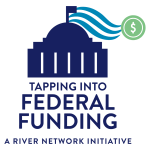Funding Water Infrastructure in Your Community with American Rescue Plan Dollars
River Network Clean Water Fellow, Erin Kanzig contributed to this blog.
As part of the response to the coronavirus pandemic, Congress passed the American Rescue Plan Act (ARPA) back in March to help revive the economy and protect public health by providing direct support to individuals as well as state, tribal, and local governments. The total package provided $1.9 trillion in relief for a wide range of purposes.
Following April Ingle’s recent blog post about federal policy, and as we’ve been working to support groups advocating for equitable water infrastructure investments in their communities, we started getting questions about how and whether ARPA funds can be used to fund water infrastructure. The short answer is YES! Here’s how it’s working as of now.
How much funding is available and when does it need to be used?
Part of ARPA targeted support for state, local, and tribal governments – a total of $350 billion is available for these entities (for more details and the breakdown see the U.S. Treasury State and Local Fiscal Recovery Funds). Some of this funding is already out the door, but much remains to be allocated as funds do not have to be obligated until December 31, 2024, and must be spent by December 31, 2026. This means that there are still opportunities to advocate for how this remaining money will be spent in many states.
What is the funding for and what are the guidelines for water infrastructure?
The funding for local, state, and tribal governments is intended to be flexible and allow communities to prioritize their highest needs within a broad range of categories, taking into account those hit hardest by the pandemic. Those categories were defined by the Treasury Department and include use of funds to:
- Support public health expenditures, by, for example, funding COVID-19 mitigation efforts, medical expenses, behavioral healthcare, and certain public health and safety staff;
- Address negative economic impacts caused by the public health emergency, including economic harms to workers, households, small businesses, impacted industries, and the public sector;
- Replace lost public sector revenue, using this funding to provide government services to the extent of the reduction in revenue experienced due to the pandemic;
- Provide premium pay for essential workers, offering additional support to those who have and will bear the greatest health risks because of their service in critical infrastructure sectors;
- Invest in water, sewer, and broadband infrastructure, making necessary investments to improve access to clean drinking water, support vital wastewater and stormwater infrastructure, and to expand access to broadband internet.
Further guidance for water infrastructure investment was provided in association with an Interim Final Rule and is clearly explained in this article by the National League of Cities. Overall, local, state and tribal governments can “[b]roadly invest in necessary improvements to their water and sewer infrastructures, including projects that address the impacts of climate change.” Projects eligible for funding align with those that also meet the criteria for Clean Water and Drinking Water State Revolving Loan Funds (SRF), which are longstanding programs administered by EPA and the states (projects don’t have to be on the state SRF list already to be eligible for ARPA investment). The SRFs support a range of project types, including building or upgrading drinking water treatment plants, green infrastructure, water efficiency and reuse and wastewater treatment plan upgrades (to learn more about projects eligible under the SRF programs see the Infrastructure section of our Equitable Water Infrastructure Toolkit).
Additionally, in their interim final rule, the Treasury Department encourages recipients “to consider green infrastructure investments and projects to improve resilience to the effects of climate change” and “projects to replace lead service lines.”
What have communities spent on water infrastructure so far?
We don’t know how much exactly has been obligated, overall or for water, but here are some examples of how this money is being directed:
- In Kentucky, the state is using $250 million for water infrastructure, including $50 million as grants for “water services to unserved, rural customers or to utilities under a federal consent decree.”
- Virginia’s spending plan will provide $411 million for clean water programs and wastewater treatment including over $5 million for well and septic system improvement for homeowners at or below 200 percent of federal poverty guidelines and $50 million to support equal access to drinking water for small and disadvantaged communities.
- As part of their plan, Maine is planning to spend $2.5 million of their ARPA funds to support drinking water treatment and environmental testing related to PFAS.
What can you do?
While some states and local governments are making plans for these funds, not all of them have, or not yet for the total amount of their full allocation. For a great example of advocacy for water infrastructure, see Texas Living Waters support of state investment in resilient approaches to water management, like water reuse. The first reports on use of the funds were due at the end of August, so hopefully we’ll have a better sense of where the money is going sometime soon. For now, check with your city, county, tribal, or state government to see what their plan is and speak up now – where opportunities for advocacy exist, your voice can help ensure these dollars are equitably distributed to those communities most at risk.
Are you already advocating for ARPA funds – let us know what you’re learning!
Learn More:
- U.S. Department of Treasury, Coronavirus State and Local Fiscal Funds
- National Association of Counties, American Rescue Plan Funding Breakdown
- National League of Cities, Using APRA Funds for Water, Wastewater and Stormwater Infrastructure Projects
- PolicyLink, 10 Priorities for Advancing Racial Equity Through the American Rescue Plan: A Guide for City and County Policymakers






